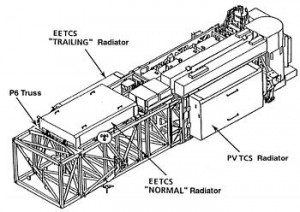
On May 9th, the current crew of the International Space Station reported seeing white flakes being vented from an area near the station’s P6 truss structure.
Further investigations using handheld cameras and remotely operated external cameras have revealed that the source of the leak was an ammonia loop, which is used for cooling the power channels onboard the station. As the leak is external, it has been reported that there is no threat to the health of the crew.
“Station’s power relies on ammonia coolant. A few hours ago, we determined that the ammonia was leaking out of the Station and into space,” announced ISS commander Chris Hadfield on Twitter. “It is a serious situation, but between crew and experts on the ground, it appears to have been stabilized. Tomorrow we find out for certain.”
However, this is not the first time an ammonia loop has sprung a leak. In November 2012, astronauts were forced to perform a spacewalk to repair another leak, which also occurred from the same loop. Each solar array contains its own cooling loop.
Thermal control engineers have estimated that at the current rate of loss, the loop could fail within 48 hours, although contingency plans are being developed that will enable the power channels to be diverted away from the failing power system, which should allow for normal operations to resume.
The ammonia cooling loops form part of the station’s active cooling system, which draws heat away from electronic systems and transfers the heat to external radiators, by means of a fluid transfer, much like a domestic refrigerator. In addition to the active systems, ISS contains several passive cooling systems which include surface coatings, heat pipes and heaters.
Ammonia was selected as the heat transfer fluid due to its all-round performance in terms of low toxicity, low flammability, freeze temperature and cost.


















































































































![A trajectory analysis that used a computational fluid dynamics approach to determine the likely position and velocity histories of the foam (Credits: NASA Ref [1] p61).](http://www.spacesafetymagazine.com/wp-content/uploads/2014/05/fluid-dynamics-trajectory-analysis-50x50.jpg)



Leave a Reply